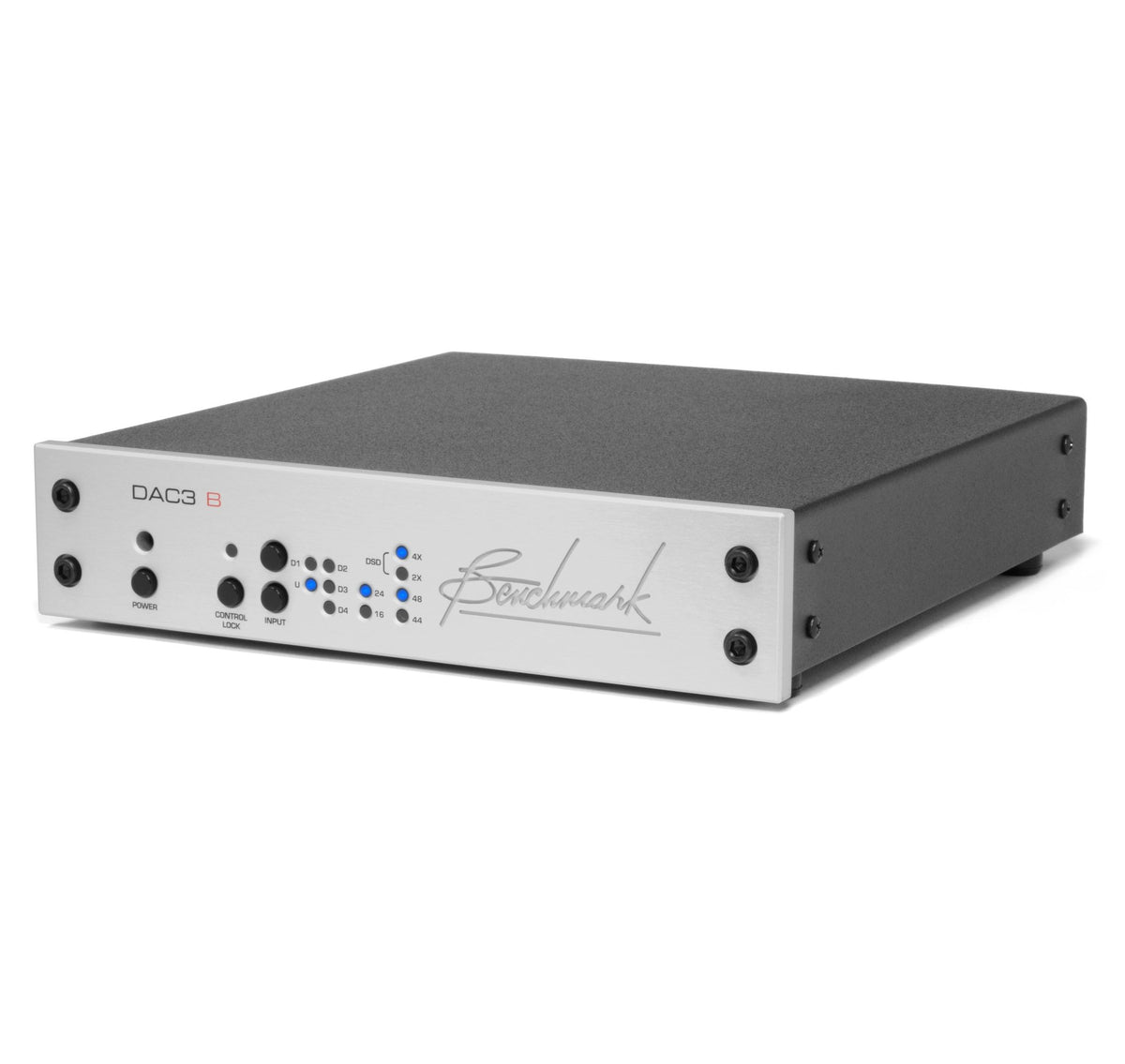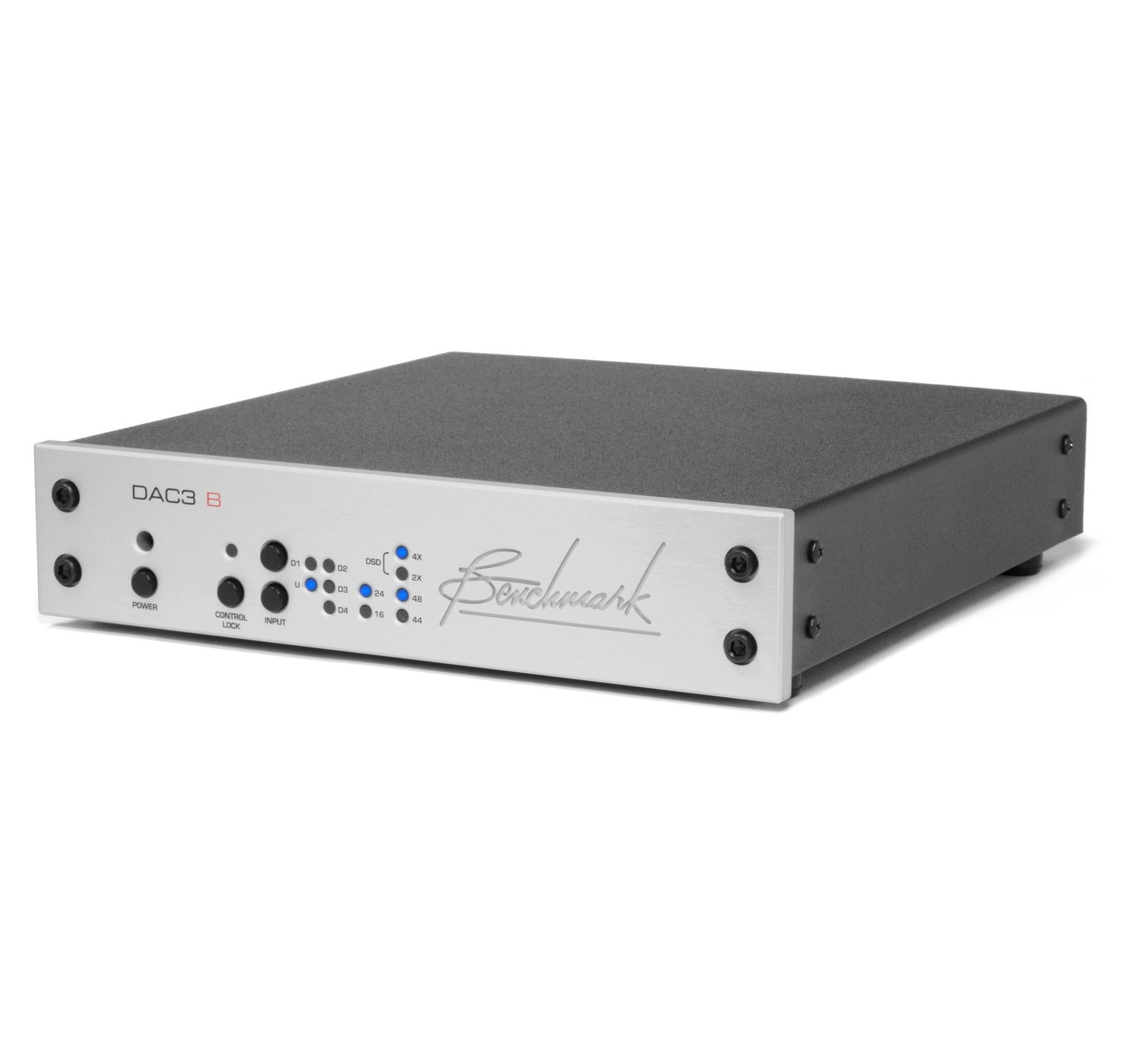
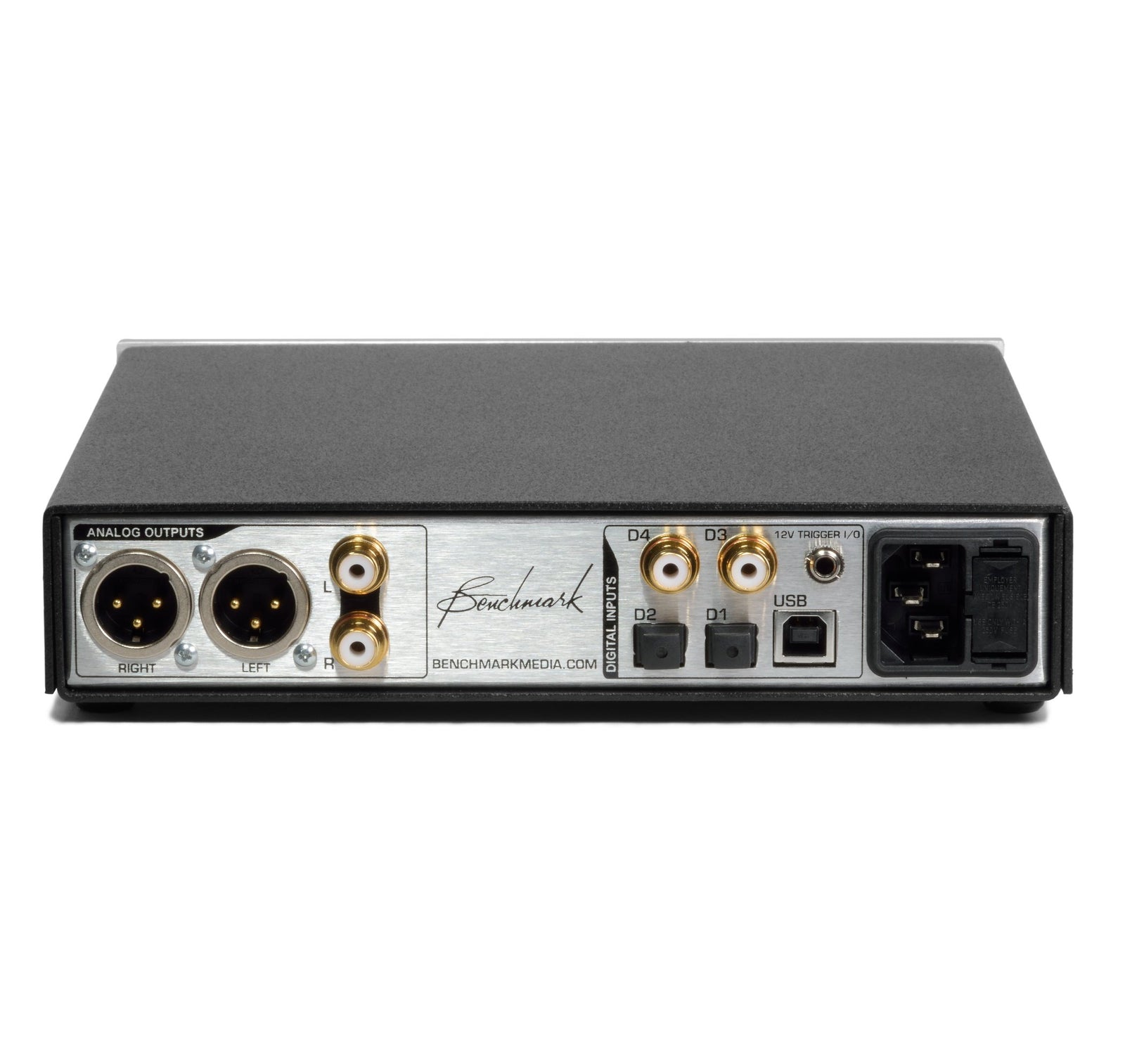
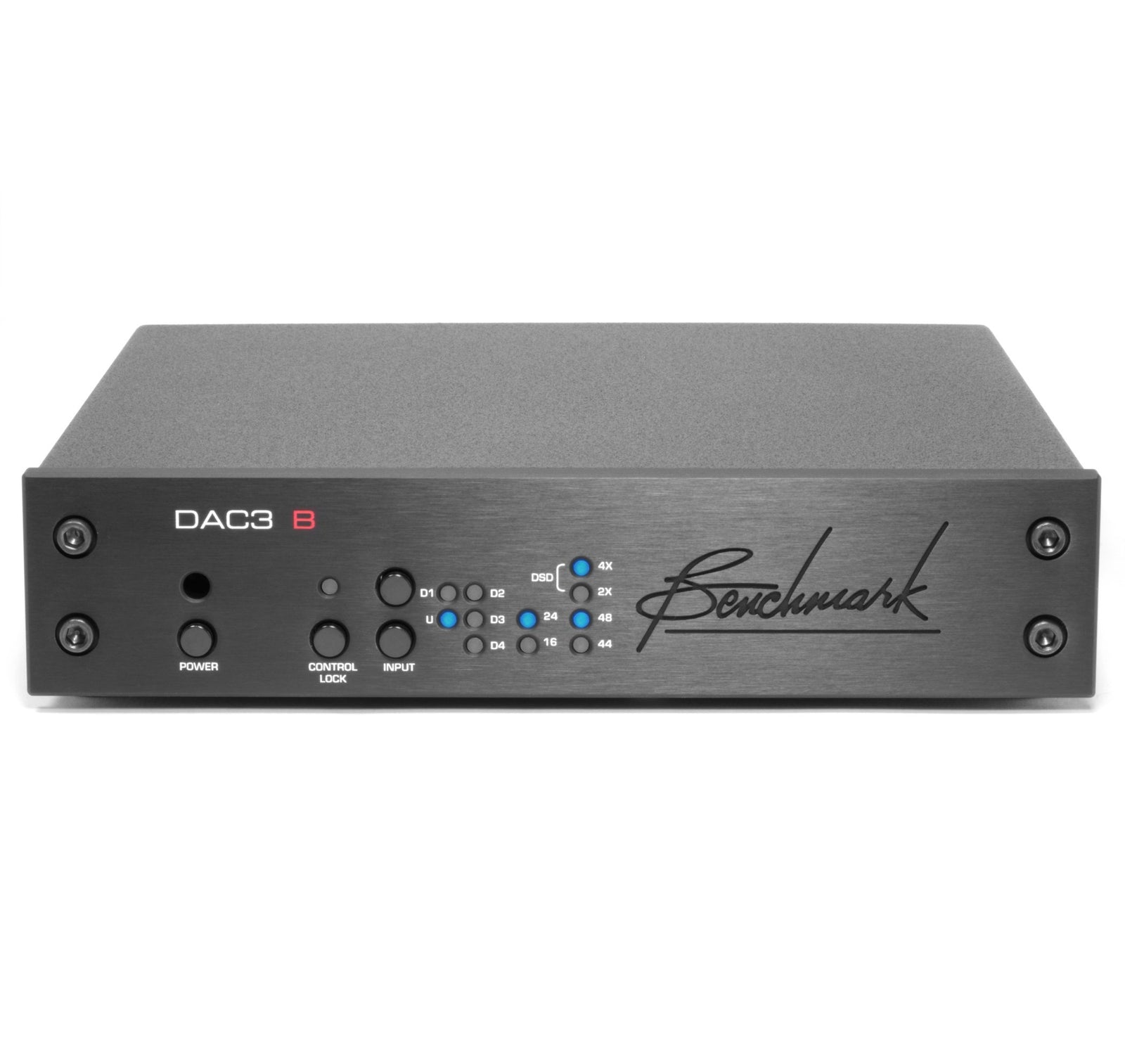
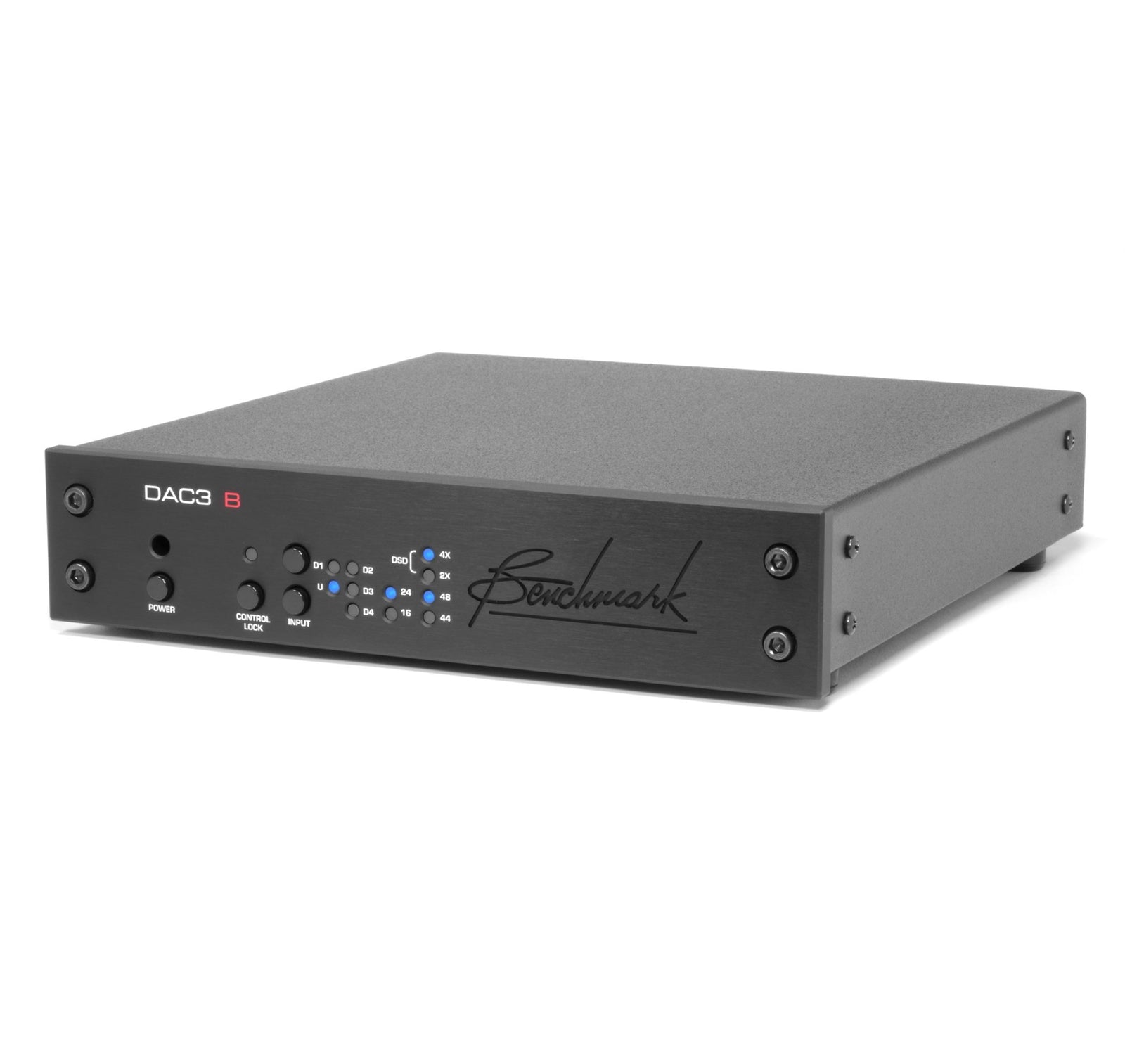
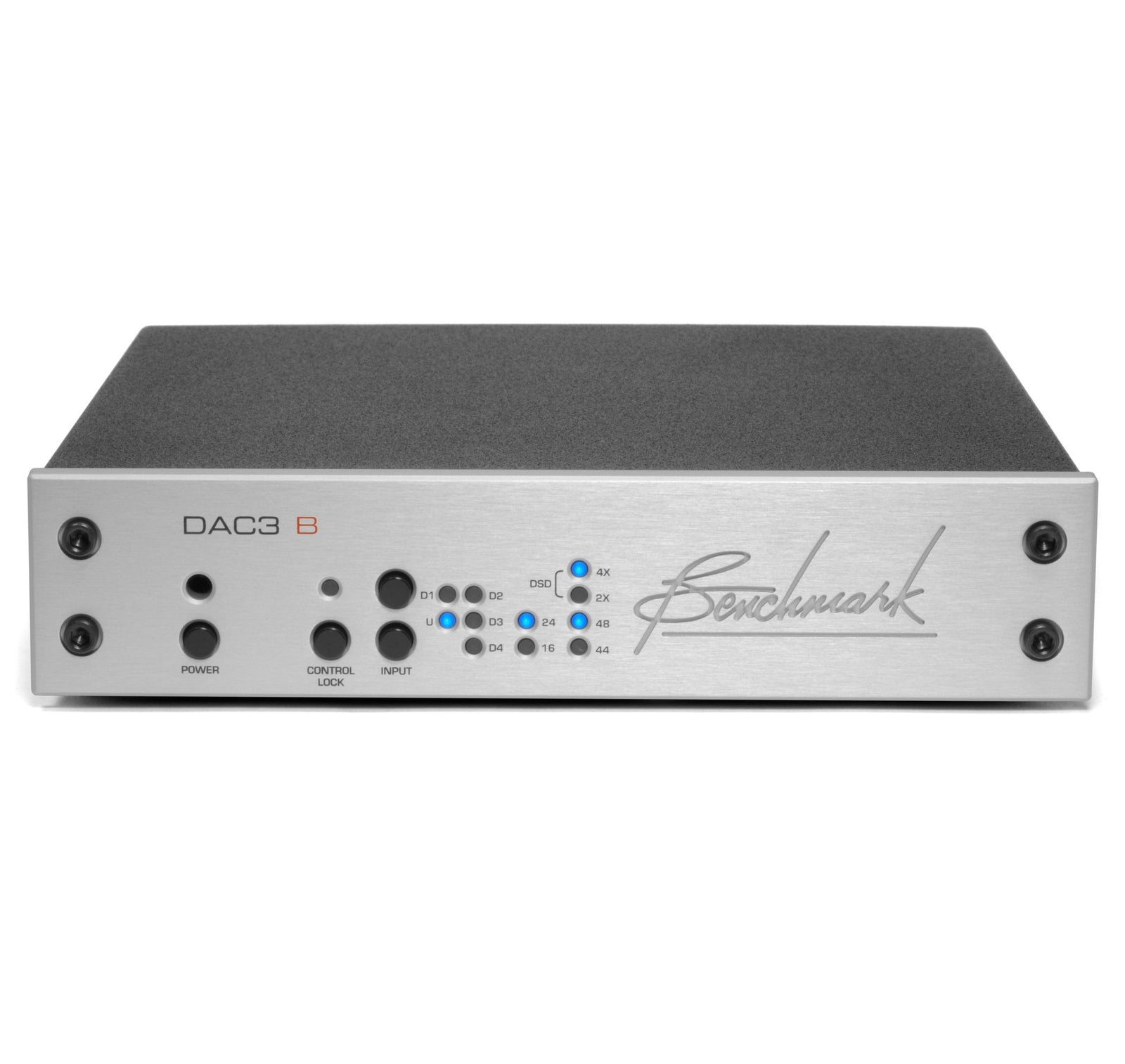
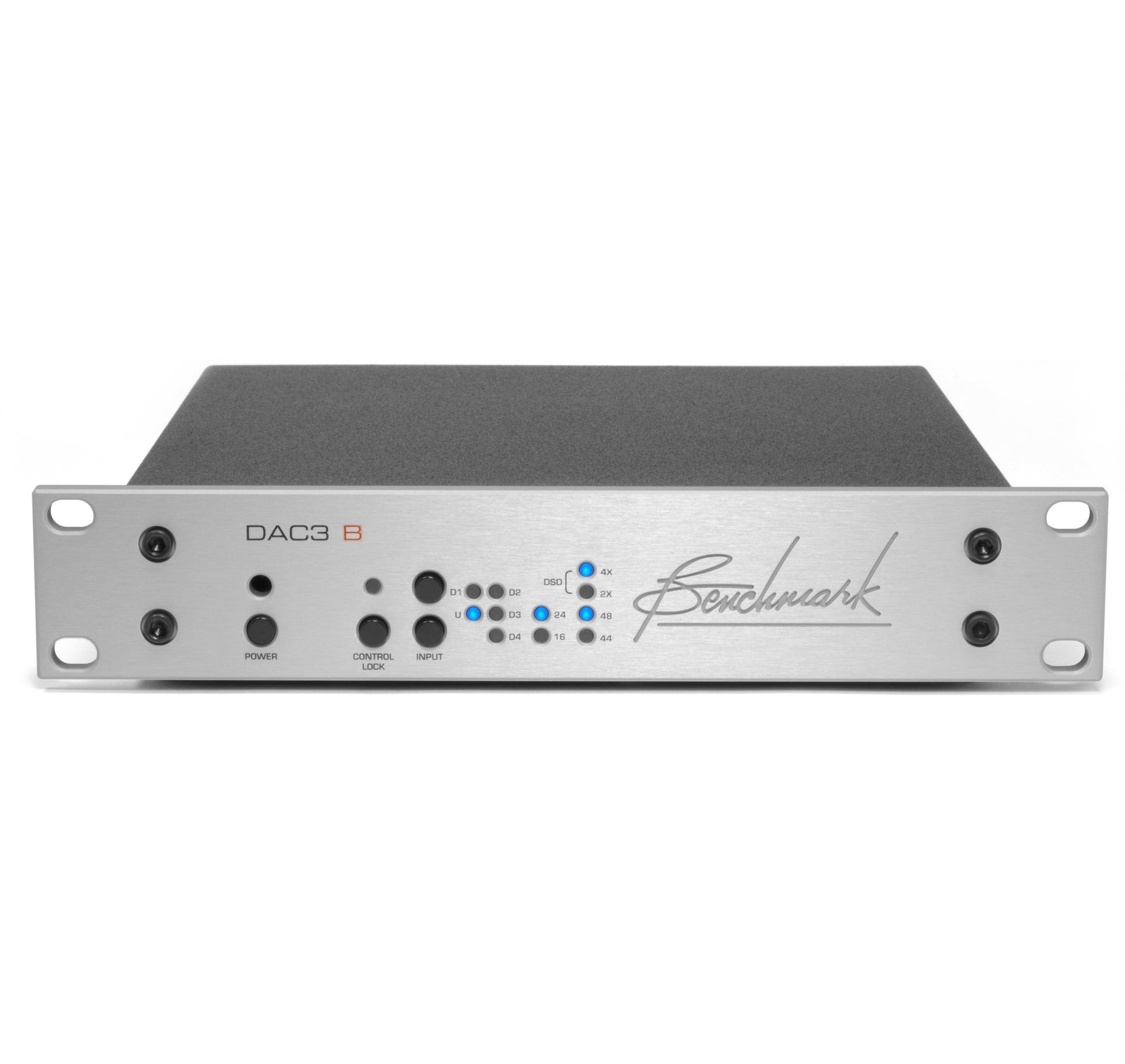
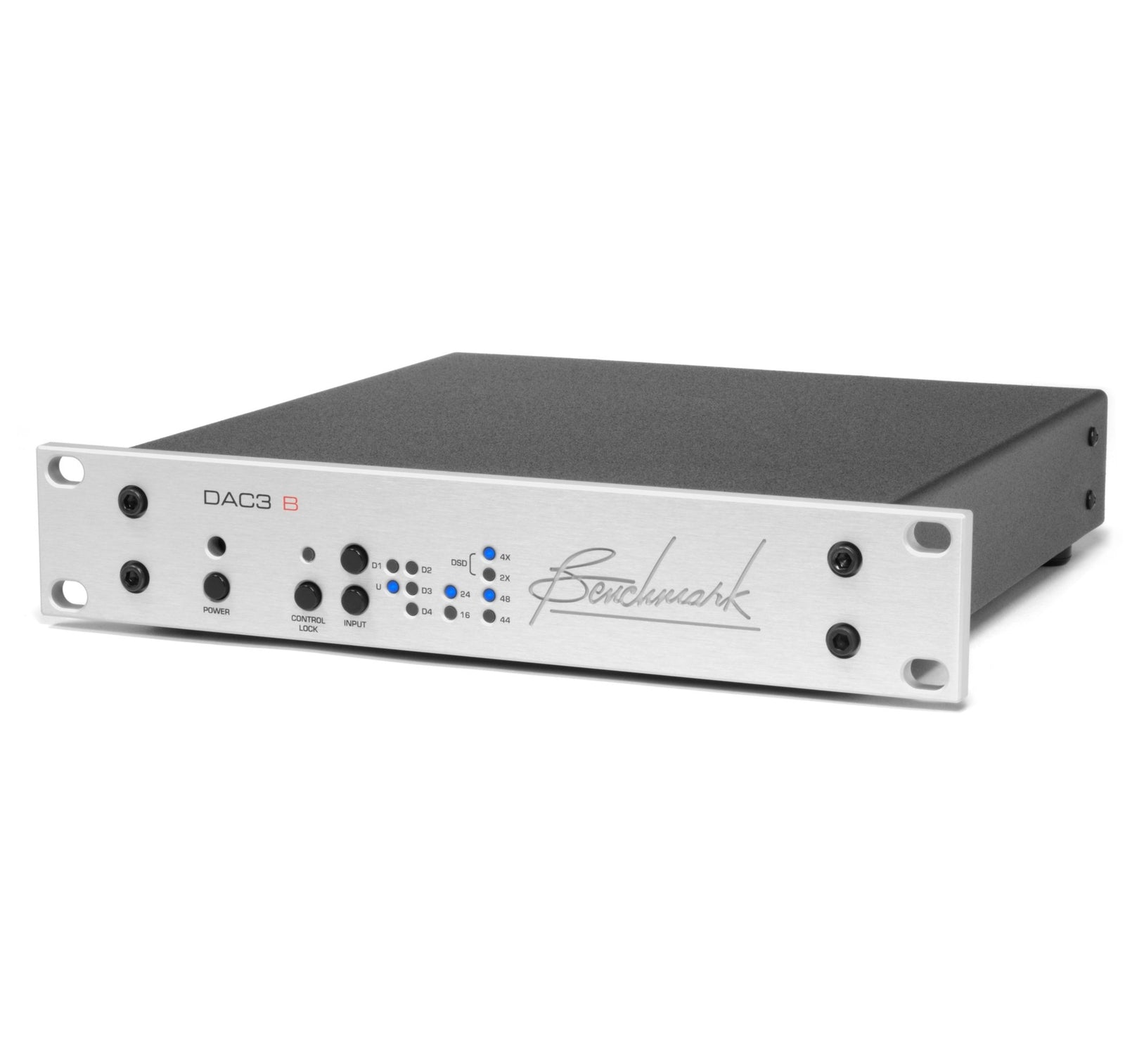
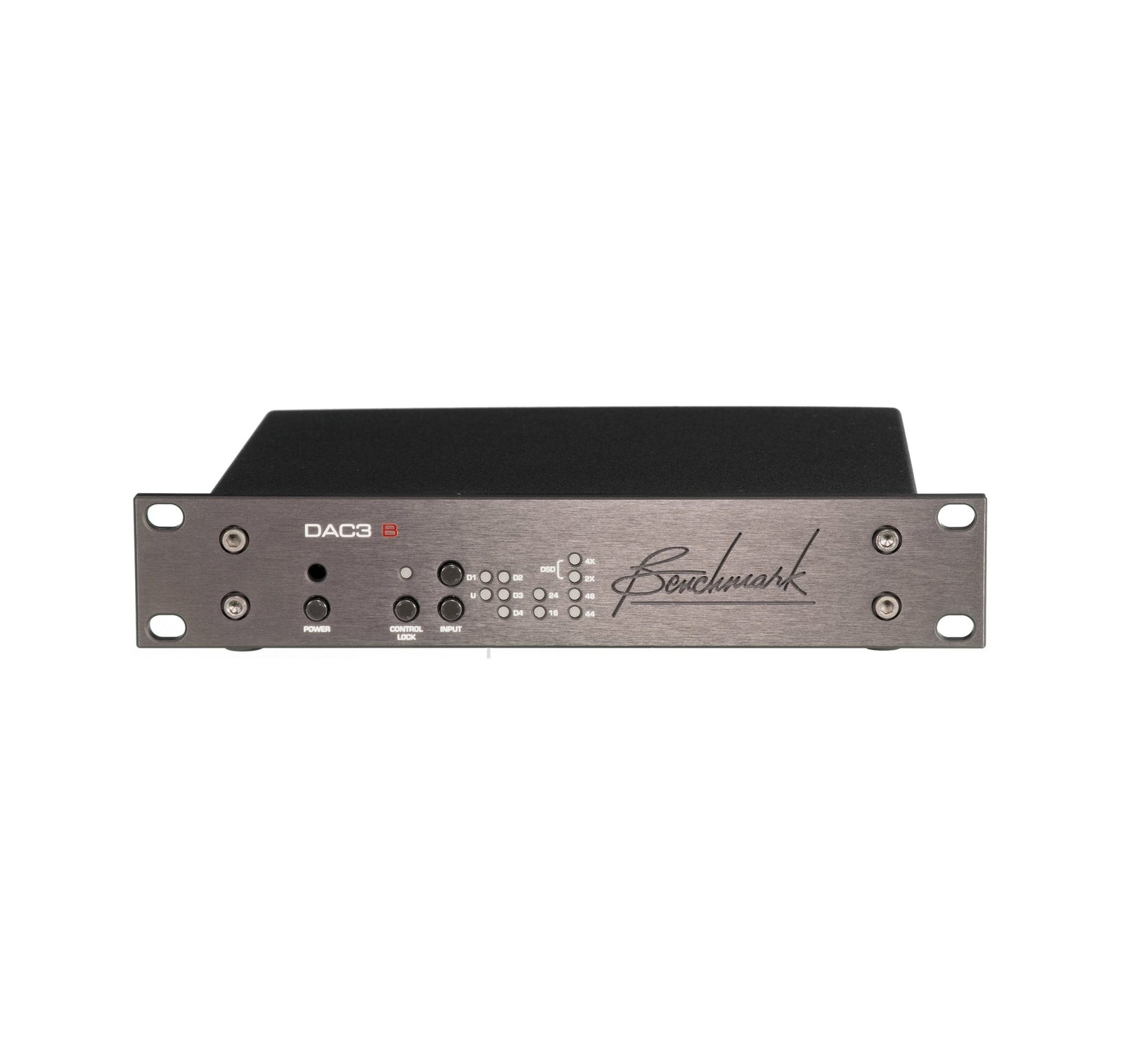
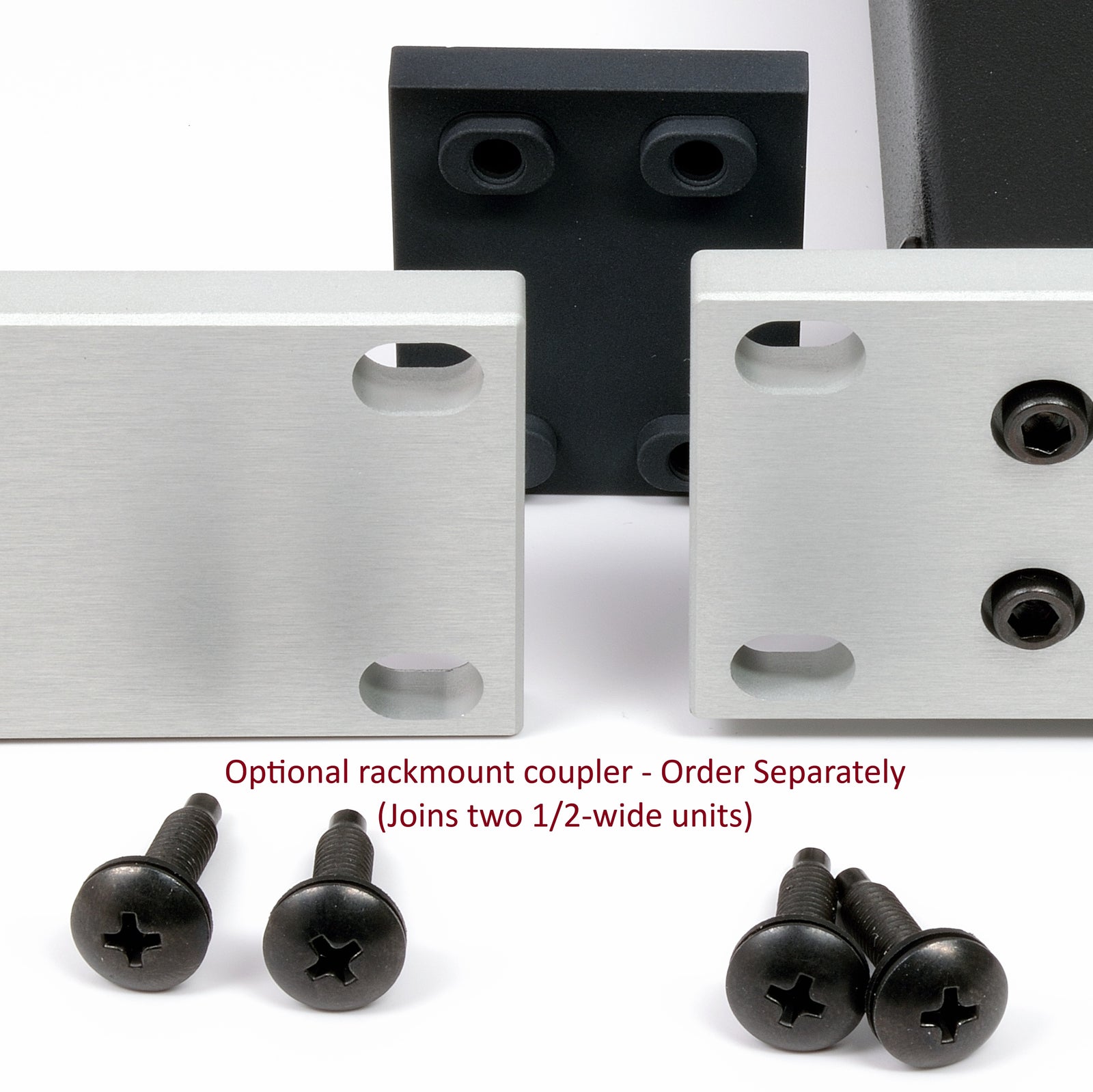

500-14800-730
Benchmark DAC3 B - Digital to Analog Audio Converter
Benchmark DAC3 converters are in daily use in many of the world's finest recording studios and mastering rooms. They are also enjoyed by thousands of audiophiles.
The DAC3 delivers outstanding musical detail and precise stereo imaging. It employs an advanced high-headroom digital filter design, and a high-sample-rate asynchronous USB audio interface. All inputs are fully isolated from interface jitter by Benchmark's new UltraLock3™ jitter attenuation system.
Internal digital processing and conversion is 32-bits, and this processing includes 3.5 dB of headroom above 0 dBFS. This headroom prevents the DSP overloads that commonly occur in other D/A converters.
Four balanced 32-bit D/A converters are summed together to create each balanced analog output. This 4:1 summation provides a 6 dB noise reduction, and gives the DAC3 industry-leading performance.
The DAC3 B is currently shipping from stock.
The DAC3 B is the ideal converter to use in front of Benchmark's HPA4 headphone amplifier or LA4 line amplifier. It is also ideal for many professional studio applications. It delivers the full performance of the flagship DAC3 HGC, but eliminates the volume control, the analog inputs, the mute and polarity controls, and the headphone amplifier.
- Overview
-
DAC3 B - Reference Quality - Basic Features
The DAC3 B is the basic D/A converter in Benchmark's DAC3 converter series. The DAC3 B is the ideal converter to use in front of Benchmark's HPA4 headphone amplifier or LA4 line amplifier. It is also ideal for many professional studio applications. It delivers the full performance of the flagship DAC3 HGC, but eliminates the volume control, the analog inputs, the mute and polarity controls, and the headphone amplifier.
To make system integration easy, the DAC3 B retains IR remote control (handset optional), 12 V trigger, and the programmable auto-on feature. The DAC3 B adds a control-lock feature that turns off the remote control and locks the keypad to prevent tampering and accidental changes. The optional 1/2-width rack-mount faceplate allows the mounting of two units in a single 1-RU rack space.
The DAC3 B sounds exactly like the DAC3 HGC because it uses the exact same circuit board and the exact same audio path. Benchmark has simply eliminated the unnecessary parts to deliver a stripped down race car of a converter. If you want a basic D/A converter that delivers the finest conversion available, the DAC3 B is for you.
The DAC3 B is a 2-channel D/A converter featuring the new ESS Technologies ES9028PRO converter chip. The DAC3 converter has lower THD and THD+N noise than Benchmark's DAC2 converters.
Benchmark's DAC1 and DAC2 D/A converter families have been the reference to which other converters have been compared. It is rare to find a converter review that does not draw comparisons to the DAC1 or the DAC2. Benchmark converters are in daily use at many of the world's finest recording studios and mastering rooms. Benchmark converters are also enjoyed by thousands of audiophiles. Benchmark has raised the bar again ... the DAC3 defines a new reference.
Reference Performance
The DAC3 delivers outstanding musical detail and precise stereo imaging. It employs an advanced high-headroom digital filter design, and a high-sample-rate Asynchronous USB Audio interface. All inputs are fully isolated from interface jitter by Benchmark's new UltraLock3™ jitter attenuation system.
Internal digital processing and conversion is 32-bits, and this processing includes 3.5 dB of headroom above 0 dBFS. This headroom prevents the DSP overloads that commonly occur in other D/A converters.
Four balanced 32-bit D/A converters are summed together to create each balanced analog output. This 4:1 summation provides a 6 dB noise reduction, and gives the DAC3 industry-leading performance.
DAC3 vs. DAC2
The DAC3 builds upon Benchmark’s highly successful DAC2 product family. The DAC3 maintains the familiar DAC2 form factor and feature set, but adds the higher performance available from the new ES9028PRO D/A converter. The DAC3 offers the following improvements over the DAC2:
- Active 2nd Harmonic Compensation
- Active 3rd Harmonic Compensation
- Lower THD+N
- Lower passband ripple
- Improved frequency response
- Faster PLL lock times
- Faster switching between input signals
DAC3 vs. DAC1
The DAC3 and DAC2 added these features that were not found on the DAC1:
- Asynchronous 192kHz USB Audio 2.0
- 32-bit D/A conversion system
- Word Length Display
- Sample Rate Display
- Direct DSD D/A Conversion
- Bi-Directional 12V Trigger
- Power Switch with Auto-On Function
- Digital Pass-Through
- High-Headroom DSP
- Additional I/O
Native DSD Conversion
All digital inputs on the DAC3 support native 192 kHz PCM or DSD64 conversion. From any input, DSD is transported with bit accuracy over DoP 1.1. DSD and PCM are both natively converted to analog. There are no DSD to PCM or PCM to DSD conversions to compromise the quality of the music. The DAC3 conversion system seamlessly switches between native PCM and native DSD conversion. DSD over DoP 1.1 is supported by many media players, and DSD downloads are now available from several sources.
Sonically-Neutral Studio Monitoring
All Benchmark converters are designed for maximum transparency. This transparency is absolutely essential in the studio monitoring chain. For this reason, DAC3 converters are ideal for critical reference-quality professional systems. Unlike many competing products, the DAC3 is not designed to add "euphonic" coloration to the audio. Instead it is designed to be as uncolored and natural as possible.
Step Into the Studio
When Benchmark's professional converters are used in hi-fi applications, studio-quality sound can be enjoyed in a home environment. Enjoy pure music without any coloration from the electronics. Hear the music exactly the way it was heard in the studio, and exactly the way the artists intended.
Discover the natural, uncolored, analog sound of the DAC3.
Sit in the Performance Space
Transparent sound can go beyond replicating the studio experience. Recordings that have been produced with a natural and unprocessed sound can transport you to the performance space. But, this can only happen when the entire playback chain is selected for maximum transparency.
This experience of "being there" cannot be created by systems that are designed to add "warmth" or "euphonic color" to the music.
- Technology
-
DAC3 Technologies
- Harmonic Compensation
- UltraLock3™ Jitter Attenuation System
- High-Headroom DSP
- Multi-Mode Asynchronous USB Audio System
- Quad 32-bit balanced D/A Conversion System
- Distributed Power Regulation
Harmonic Compensation
The ES9028PRO has two distortion compensation systems that independently remove most of the 2nd and 3rd harmonic distortion in the D/A converter. Benchmark's ultra-clean analog output stages allow these systems to be fully leveraged in the DAC3. To the best of our knowledge, no other D/A converter has lower THD than the Benchmark DAC3.
UltraLock3™ Jitter Attenuation System
UltraLock3™ is an improved version of the UltraLock2™ system used in the DAC2 product family. UltraLock3™ locks with precise phase accuracy in only 6 ms. In contrast, the UltraLock2™ system required 400 ms. Both UltraLock™ systems provide virtually perfect jitter attenuation, but the lightning-fast lock time of the new UltraLock3™ will be appreciated by many of our users.
DSP processing is 32-bits, DSP headroom is 3.5 dB, sample rate is 211 kHz, and jitter-induced distortion and noise is at least 140 dB below the level of the music - well below the threshold of hearing. Benchmark's UltraLock3™ system eliminates all audible jitter artifacts.
High Headroom DSP - with 3.5 dB "Excess" Digital Headroom
All of the digital processing in the DAC3 is designed to handle signals as high as +3.5 dBFS. Most digital systems clip signals that exceed 0 dBFS. The 0 dBFS limitation seems reasonable, as 0 dBFS is the highest sinusoidal signal level that can be represented in a digital system. However, a detailed investigation of the mathematics of PCM digital systems will reveal that inter-sample peaks may reach levels slightly higher than +3 dBFS while individual samples never exceed 0 dBFS. These inter-sample overs are common in commercial releases, and are of no consequence in a PCM system until they reach an interpolation process. But, for a variety of reasons, virtually all audio D/A converters use an interpolation process. The interpolation process is absolutely necessary to achieve 24-bit state-of-the art conversion performance. Unfortunately, inter-sample overs cause clipping in most interpolators. This clipping produces distortion products that are non-harmonic and non-musical . We believe these broadband distortion products often add a harshness or false high-frequency sparkle to digital reproduction. The DAC3 avoids these problems by maintaining at least 3.5 dB of headroom in the entire conversion system. We believe this added headroom is a groundbreaking improvement.
Multi-Mode Asynchronous USB System
Benchmark's USB system supports USB Audio 2.0 and DSD. It is frequency agile, and will follow sample rate changes initiated by the computer and/or the media playback software. In all modes the USB communications are asynchronous in order to eliminate unnecessary sources of jitter.
The DAC3 has a low-jitter master clock which controls the transfer of audio data from the computer to the USB sub-system. The computer asynchronously transfers audio data to a buffer in the DAC3. The contents of the buffer are then asynchronously transferred to the D/A conversion subsystem. This second asynchronous transfer eliminates any traces of jitter that accumulate as the data is transferred between the USB and conversion subsystems. No traces of jitter-induced distortion are measurable to our measurement limits (better than -150 dBFS). This truly represents the state-of-the art. Enjoy the convenience of computer playback without compromise. The Asynchronous USB system supports USB Audio 2.0 for high-resolution 192kHz, and DSD playback. No drivers are required for MAC operating systems. An easy-to-install driver adds 192 kHz and DSD capabilities to Windows operating systems.
The USB subsystem remains active when the DAC3 is powered down. This prevents interruptions to the computer playback operations and eliminates the need to reconfigure the computer every time the converter is turned on.Quad 32-bit Balanced Conversion System
Four balanced 32-bit D/A converters deliver audio to Benchmark's low-impedance current to voltage converters. The 4:1 redundancy reduces noise and distortion to levels that set new benchmarks. The conversion system at the core of the DAC3 is as good as it gets. The analog circuits that follow the D/A converter are carefully designed. Benchmark has leveraged its long history of building high-end analog audio equipment, in order to create an outstanding output stage.
The conversion system in the DAC3 achieves a 6 dB signal to noise improvement through the use of 4:1 summing. The ES9028PRO D/A is an 8-channel 32-bit converter. In the DAC3, four channels are summed in the analog domain to form each of the two output channels.
The 4:1 summing also improves the THD. The non-linearities in individual conversion channels are averaged across the four summed channels and incoherent non-linearities are attenuated by 6 dB.
Diagnostic Tools - Sample-Rate and Word-Length Indicators
Ever wonder why that 192 kHz 24-bit download on your computer just doesn't sound right? Your media player may be down-sampling to 44.1 kHz and/or truncating to 16-bits. Many computers and media players apply poor-quality sample rate conversion and truncation. Fortunately these problems can be eliminated with the selection a good frequency-agile media player. The sample-rate and word-length displays on the DAC3 confirm the proper operation of your media player.
Control Lock
The DAC3 B can be locked to avoid accidental changes that could cause a loss of audio in dedicated applications. This feature disables the IR remote control and the front panel buttons.
Digital Pass Through
The second coaxial input on the DAC3 can be reconfigured as a digital output. In output mode, any selected digital input (including USB) will pass through to the coaxial output. The digital pass through is bit-transparent and even supports DSD (DoP 1.1). Dolby digital and DTS formats can also be passed through to a surround processor.
Bi-Directional 12 Volt Trigger
Benchmark re-invents the 12 volt trigger. The trigger connection on the DAC2 can be used as an input, an output, or both. It is compatible with any common 12 volt trigger input or output. The trigger can be used to turn a power amplifier on or off automatically. The DAC3 will also respond to a 12 volt trigger to follow the actions of another audio component.
Power Switch
The power switch can place the DAC3 in standby, or full shut down. In full shut down, the unit will still respond to the trigger input and the IR remote control. Power consumption is less than 0.5 W in full shut down.
Low Power Consumption
The DAC3 uses high-efficiency low noise power supplies and may be operated from any standard international voltage without adjustment. Power consumption is 12 W typical.
Distributed Power Regulation
To achieve the lowest possible noise, the DAC3 uses distributed power supply regulation. Each critical subsystem has at least one dedicated low-noise voltage regulator.
- Awards
- Reviews
-



See more reviews - Specifications
-
Audio Performance
Fs = 44.1 to 96 kHz, 20 to 20 kHz BW, 1 kHz test tone, 0 dBFS = +24 dBu (unless noted)
SNR – A-Weighted, 0 dBFS = +24 dBu
125 dB, 128 dB relative to intersample peaks
SNR – Unweighted, 0 dBFS = +24 dBu
123 dB, 126 dB relative to intersample peaks
THD+N, 1 kHz at 0 dBFS
-113 dBFS, -113 dB, 0.00022%
THD+N, 1 kHz at -1 dBFS
-114 dBFS, -113 dB, 0.00022%
THD+N, 1 kHz at –3 dBFS
-119 dBFS, -116 dB, 0.00016%
THD+N, 20 to 20 kHz test tone at –3 dBFS
-113 dBFS, -110 dB, 0.00032%
Frequency Response at Fs=192 kHz
- +0 dB, -0.015 dB (20 to 20 kHz)
- -0.015 dB at 10 Hz
- -0.005 dB at 20 kHz
- -0.031 dB at 40 kHz
- -0.15 dB at 80 kHz
Frequency Response at Fs=48 kHz
- +0 dB, -0.015 dB (20 to 20 kHz)
- -0.015 dB at 10 Hz
- -0.005 dB at 20 kHz
Crosstalk
- -137 dB at 20 Hz
- -130 dB at 1 kHz
- -116 dB at 20 kHz
Maximum Amplitude of Jitter Induced Sidebands (10 kHz 0 dBFS test tone, 12.75 UI sinusoidal jitter at 1 kHz)
< -144 dB
Maximum Amplitude of Spurious Tones with 0 dBFS test signal
< -138 dB
Maximum Amplitude of Idle Tones
< -147 dB
Maximum Amplitude of AC line related Hum & Noise
< -133 dB
Inter-channel Differential Phase (Stereo Pair – any sample rate)
+/- 0.25 degrees at 20 kHz
Inter-channel Differential Phase (Between DAC3 Units Fs<110 kHz) Any sample rate.
+/- 0.25 degrees at 20 kHz
Maximum Lock Time after Fs change
6 ms
Soft Mute Ramp Up/Down Time
9.6 ms
Mute on Receive Error
Yes
Mute on Lock Error
Yes
Mute on Idle Channel
No
50/15 us De-Emphasis Enable
Automatic in Consumer Mode
De-Emphasis Method
Digital IIR
De-Emphasis Supported at
Fs = 32, 44.1, 48 kHz
Group Delay (Latency)
Delay – Digital Input to Analog Output (function of sample rate)
1.36 ms at 44.1 kHz
1.27 ms at 48 kHz
0.90 ms at 88.2 kHz
0.82 ms at 96 kHz
0.51 ms at 176.4 kHz
0.47 ms at 192 kHz
Digital Audio Inputs
Number of Digital Inputs (switch selected)
5 (1 USB, 2 Optical, 2 Coaxial)
Number of Channels
2
Input Sample Frequency Range
28 to 210 kHz (Coaxial Inputs)
28 to 96 kHz (Optical Inputs)
44.1, 48, 88.2, 96, 176.4, 192 kHz (USB Input)
Maximum Input Word Length
24 bits
Digital Input Impedance
75 Ohms (Coaxial Inputs)
DC Blocking Capacitors on Digital Inputs
Yes (Coaxial Inputs)
Transient and Over-Voltage Protection on Digital Inputs
Yes (Coaxial Inputs)
Minimum Digital Input Level
250 mVpp (Coaxial Inputs)
Jitter Tolerance
(With no Measurable Change in Performance)
>12.75 UI sine, 100 Hz to 3 kHz
>1.5 UI sine at 20 kHz
>1.5 UI sine at 40 kHz
>1.5 UI sine at 80 kHz
>1.5 UI sine at 90 kHz
>0.25 UI sine above 160 kHz
Jitter Attenuation Method
Benchmark UltraLock3™ - all inputs
Balanced Analog Outputs
Number of Balanced Analog Outputs
2
Output Connector
Gold-Pin Neutrik™ male XLR
Output Impedance
60 Ohms (Attenuator off)
425 Ohms (Attenuator = 10 dB)
135 Ohms (Attenuator = 20 dB)
Analog Output Clip Point
+30 dBu
Factory Calibration (at 0 dBFS)
+24 dBu (Attenuator off)
Output Level Variation with Sample Rate (44.1 kHz vs. 96 kHz)
< +/- 0.006 dB
Unbalanced Analog Outputs
Number of Unbalanced Analog Outputs
2
Output Connector
RCA
Output Impedance
30 Ohms
Analog Output Clip Point
+13.5 dBu (3.7 Vrms)
Factory Calibration (at 0 dBFS)
+8.2 dBu (2 Vrms)
Output Level Variation with Sample Rate
< +/- 0.006 dB
Status Display
Indicators - Type and Location
12 LED’s on Front Panel
Selection/Status Indication
1 – Control Lock
5 – Input
2 – Word length
4 – Sample Rate
AC Power Requirements
Nominal Input Operating Voltage Range (VAC RMS)
100 – 240V
Frequency
50-60 Hz
Power
< 0.5 Watts Idle
12 Watts Typical Program
13 Watts MaximumFuses
5 x 20 mm (2 required)
0.5 A 250 V Slo-Blo® TypeMin/Max Operating range (VAC RMS)
90 – 260 VAC
47 – 63 Hz
Dimensions
Form Factor
½ Rack Wide, 1 RU High
Depth behind front panel
8.5” (216 mm)
Overall depth including connectors but without power cord
9.33” (237 mm)
Width
9.5” (249 mm)
Height
1.725” (44.5 mm)
Weight
DAC3 only
3 lb.
DAC3 with remote control, power cord, extra fuses, and manual
4 lb.
Shipping weight
7 lb.
Important Features
- Sample Rate Display
- Word Length Display
- 5 Digital Inputs
- 2 Stereo Analog Outputs (1 RCA, 1 XLR)
- Digital Pass Through
- Native DSD Conversion
- Control-lock Switch
- Asynchronous USB 2.0
- Bi-Directional 12 Volt Trigger
- Power Switch
- Low Power Consumption
- ES9028PRO Converter
Manual
Detailed specifications and performance plots are available in the downloadable manual.
- Accessories
-
Accessories
- Downloads
-
Manual
Driver
Windows operating systems prior to Windows 10 require a driver when operating in USB Audio 2.0 mode. USB Audio 2.0 mode is required for sample rates over 96 kHz. No driver is required for Mac or Linux operating systems.
More DAC2 and DAC3 Reviews
DESIGNED, ASSEMBLED, AND TESTED IN THE USA
This Benchmark product was designed, assembled, and tested in the USA using USA and imported components. Most major components are made in USA.


